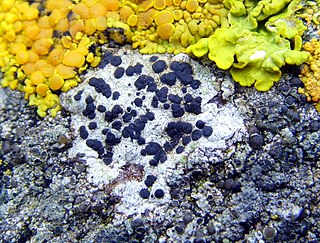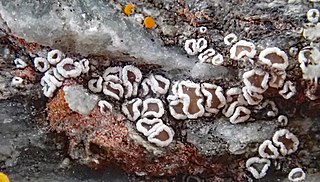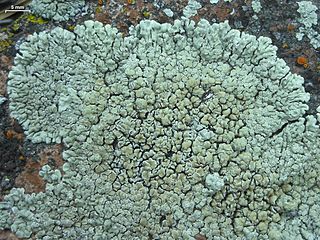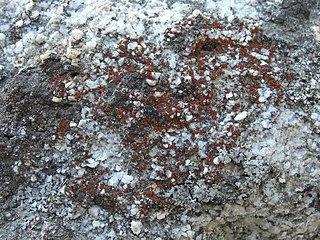Biatorellaceae is a family of lichen-forming fungi in the subclass Lecanoromycetidae. The family is monotypic, and contains the single genus Biatorella, which contains eight species.

Lecanora is a genus of lichen commonly called rim lichens. Lichens in the genus Squamarina are also called rim lichens. Members of the genus have roughly circular fruiting discs (apothecia) with rims that have photosynthetic tissue similar to that of the nonfruiting part of the lichen body (thallus). Other lichens with apothecia having margins made of thallus-like tissue are called lecanorine.
Rimularia is a genus of lichenized fungi in the family Trapeliaceae. Rimularia was circumscribed by Finnish botanist William Nylander in 1868.

Acarospora is a genus of mostly lichen-forming fungi in the family Acarosporaceae. Most species in the genus are crustose lichens that grow on rocks in open and arid places all over the world. They may look like a cobblestone road or cracked up old paint, and are commonly called cobblestone lichens or cracked lichens. They usually grow on rock, but some grow on soil (terricolous) or on other lichens. Some species in the genus are fungi that live as parasites on other lichens. Acarospora is a widely distributed genus, with about 128 species according to a 2008 estimate.

Diplotomma is a genus of lichenized fungi in the family Caliciaceae. The genus has a widespread distribution and contains about 29 species. The genus was circumscribed by Julius von Flotow in 1849. It was later wrapped into Buellia before being segregated from that genus by David Hawksworth in 1980.
Thelocarpon is a genus of fungi in the family Thelocarpaceae.

Carbonea is a genus of fungi in the family Lecanoraceae. Most of the species grow on lichens. The genus is widespread, and contains 20 species. Carbonea was originally circumscribed as a subgenus of Lecidea in 1967 before it was promoted to generic status in 1983.
Arthopyrenia is a genus of fungi within the Arthopyreniaceae family. The genus has a widespread distribution, a cosmopolitan distribution. It formerly contained about 117 species.
Siphula is a genus of lichenized fungi in the Icmadophilaceae family. The widespread genus contains about 33 species. Siphula was circumscribed by Swedish mycologist Elias Fries in 1831.

Stereocaulon is a genus of lichens. Members of Stereocaulon are commonly called snow lichens.

Lobothallia is a genus of lichens in the family Megasporaceae. Species in the genus have foliose thalli that become crustose areolate in the center with age, and grow on calcareous to siliceous rocks. The crustose part of the body may keep its lower cortex, though not always. Dark brown to black apothecia may be sunken into the surface of the thallus, as indicated in the common name puffed sunken disk lichen. Members grow to 3–5 cm (1.2–2.0 in) or more radiating lobes (placodioid). The photobiont is green alga from the genus Trebouxia. The genus is represented in Eurasia, Asia, North Africa, Central America, western North America, and Australia.

Myriolecis is a genus of lichen in the family Lecanoraceae. It was originally circumscribed in 1909 by Frederic E. Clements with Myriolecis sambuci as the type species. The genus was later reinstated to accommodate the Lecanora disperse group and Arctopeltis. Molecular phylogenetic data showed that this group of species formed a clade that is genetically distinct from Lecanora, and Myriolecis was the oldest name available to hold these species.

Protoparmeliopsis is a genus of crustose lichens in the family Lecanoraceae. It has about 20 species. The genus was circumscribed by French botanist Maurice Choisy in 1929.

Rufoplaca is a genus of lichen-forming fungi in the family Teloschistaceae. The genus was circumscribed in 2013 by Ulf Arup, Ulrik Søchting, and Patrik Frödén.
Strangospora is a genus of lichen-forming fungi. It is the only genus in the family Strangosporaceae, which itself is of uncertain taxonomic placement in the Ascomycota. It contains 10 species.
Oxneriaria is a genus of lichen-forming fungi in the family Megasporaceae. It has nine species, all of which are saxicolous (rock-dwelling), crustose lichens. The genus was circumscribed in 2017 by Sergey Kondratyuk and László Lőkös to contain species formerly in the Aspicilia mashiginensis species group. This species, now the type of the genus, was first described scientifically by Alexander Zahlbruckner as Lecanora mashiginensis. The genus name honours Ukrainian lichenologist Alfred Oxner, who, according to the authors, "provided important contribution [sic] to taxonomy of aspicilioid lichens and to biodiversity of polar lichens".








